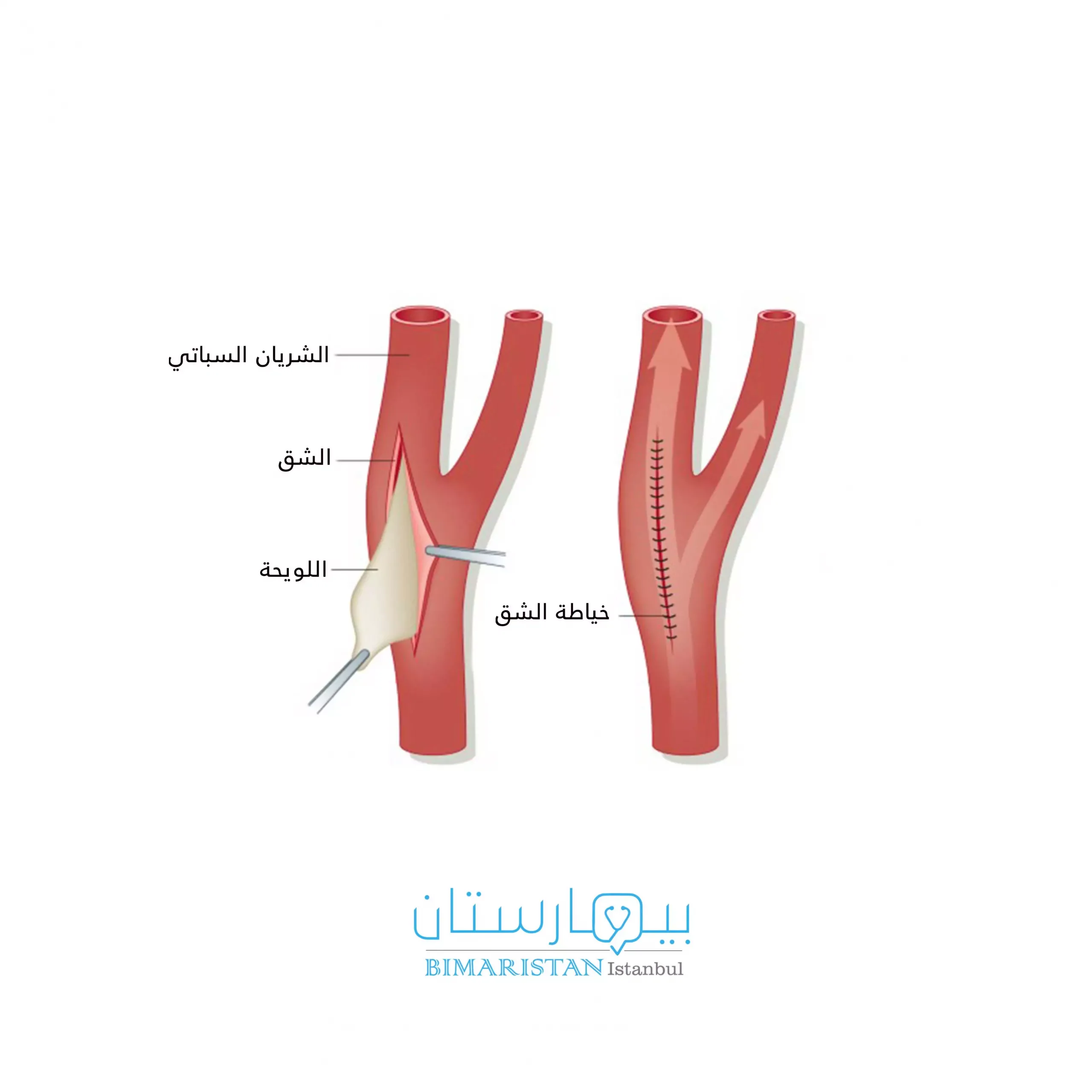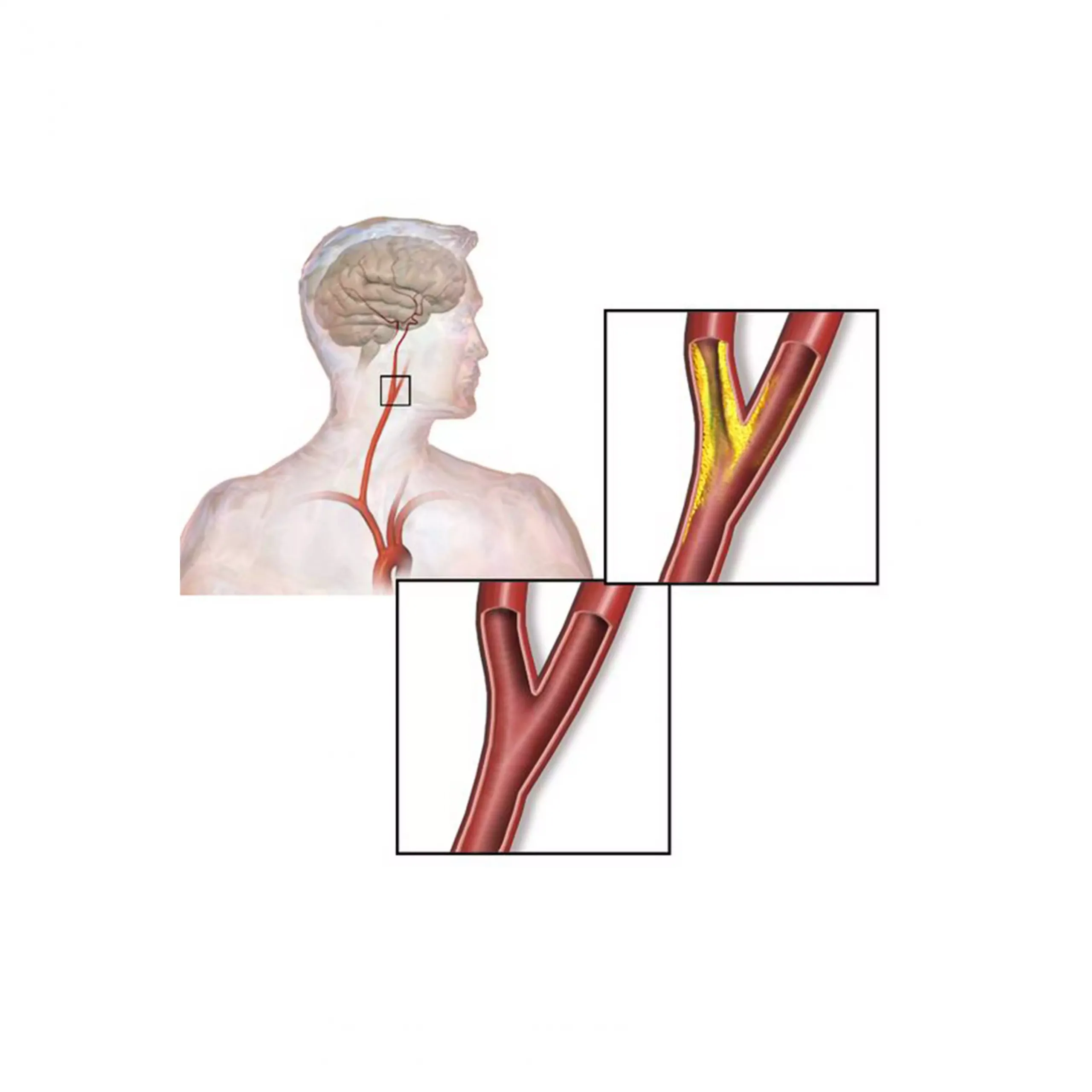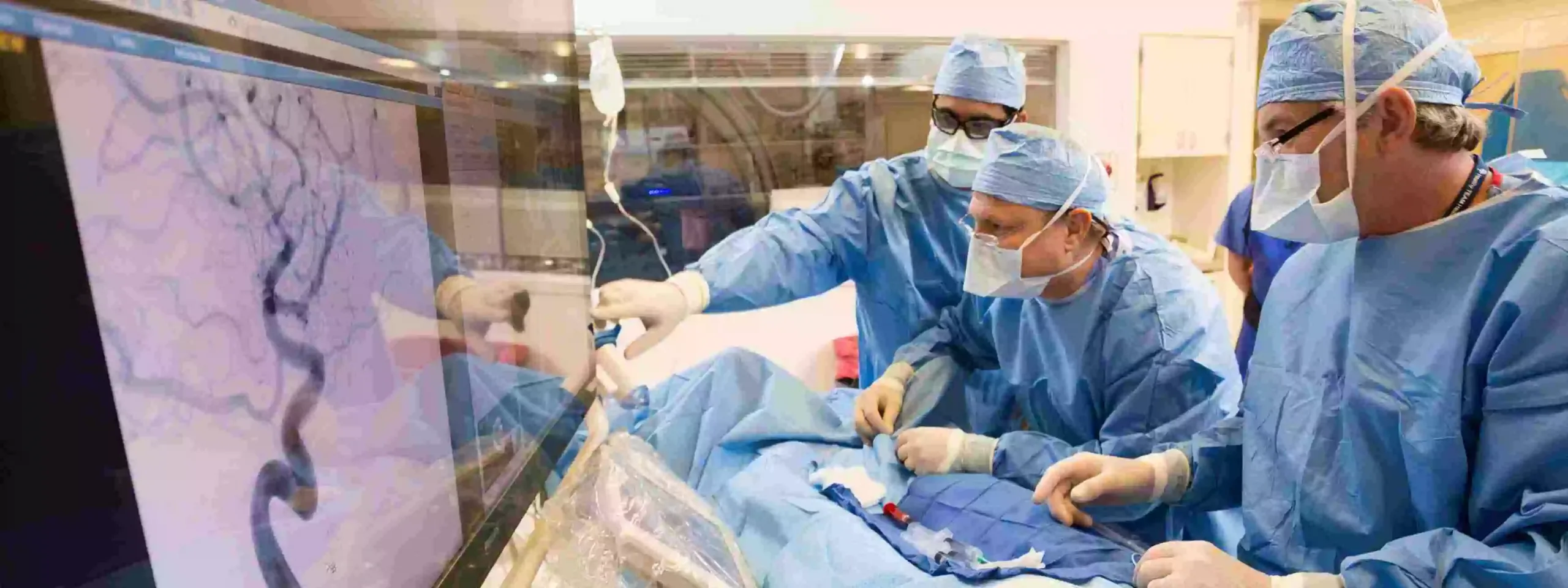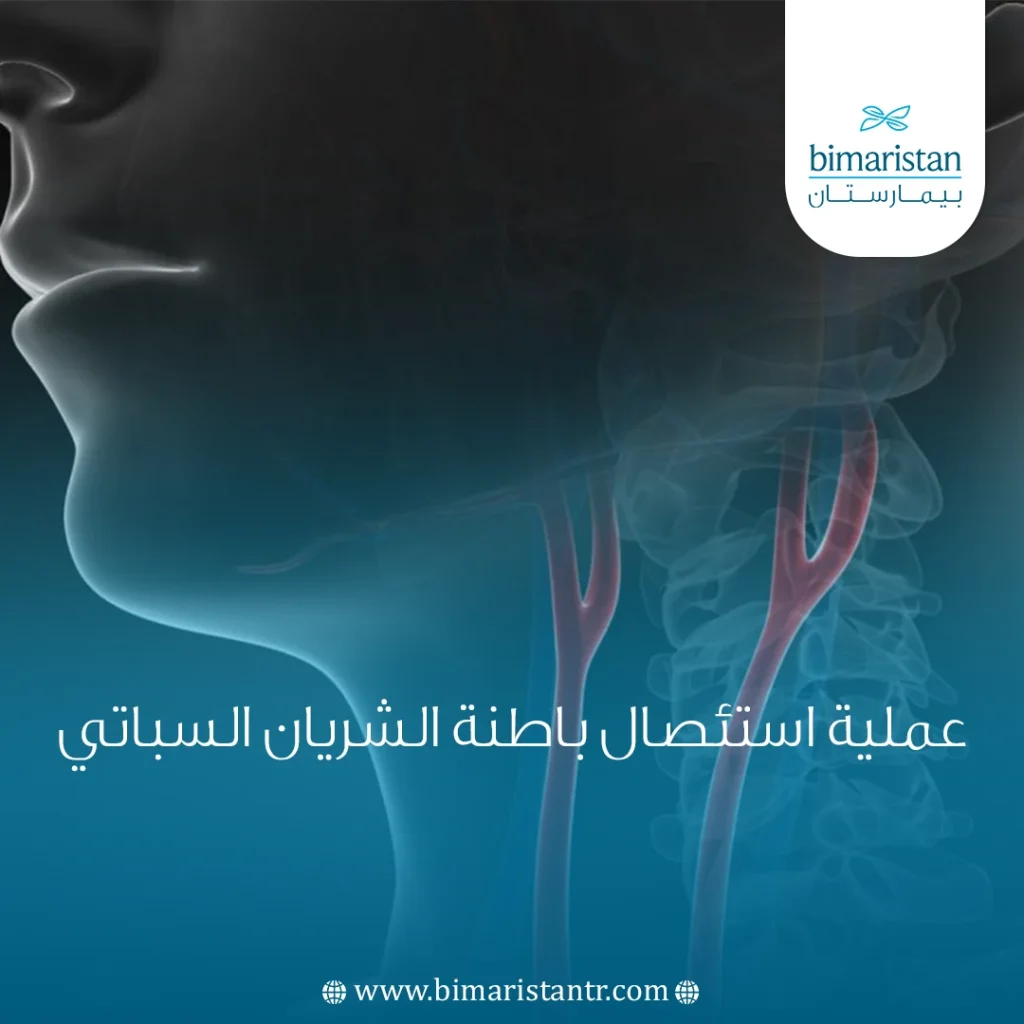ما هو استئصال باطنة الشريان السباتي؟
استئصال باطنة الشريان السباتي (CEA) هي عملية جراحية لعلاج مرض الشريان السباتي. الشريان السباتي هي الأوعية الدموية الرئيسية التي تحمل الأكسجين والدم إلى الدماغ. في مرض الشريان السباتي، تتضيق هذه الشرايين. هذا يقلل من تدفق الدم إلى الدماغ ويمكن أن يسبب سكتة دماغية.
عند الأذية الدماغية اإجراء استئصال باطنة الشريان السباتي، سيزيل مقدم الرعاية الصحية جراحيًا اللويحات التي تتراكم داخل الشريان السباتي الداخلي. سيقوم هوأوهي باستئصال باطنة الشريان عن طريق عمل قطع (شق) في جانب العنق فوق الشريان السباتي المصاب. يتم فتح الشريان وإزالة اللويحة. سيقوم مقدم الرعاية الصحية الخاص بك بخياطة الشريان معًا مرة أخرى. هذا يعيد تدفق الدم الطبيعي إلى الدماغ. قد تخضع لهذا الإجراء أثناء استيقاظك تحت تأثير التخدير الموضعي أو أثناء نومك تحت تأثير التخدير العام.

لماذا قد أحتاج إلى استئصال باطنة الشريان السباتي؟
استئصال باطنة الشريان السباتي هو إجراء يحصل بسبب تضيق الشريان السباتي بسبب تصلب الشرايين. هذا هو تراكم الترسبات في البطانة الداخلية للشريان. تتكون اللويحة من مواد دهنية وكوليسترول ومنتجات نفايات خلوية والكالسيوم والفيبرين، يُطلق على تصلب الشرايين أيضًا اسم “التصلب العصيدي”. يمكن أن يؤثر على الشرايين في جميع أنحاء الجسم. يشبه مرض الشريان السباتي مرض الشريان التاجي. في مرض الشريان التاجي، تتشكل انسدادات في شرايين القلب وقد تسبب نوبة قلبية. في الدماغ، يمكن أن يؤدي إلى سكتة دماغية.
يحتاج الدماغ إلى إمداد مستمر بالأكسجين والمواد المغذية ليعمل بشكل صحيح.
حتى الانقطاع القصير في إمداد الدم يمكن أن يسبب مشاكل صحية. حيث تبدأ خلايا الدماغ في الموت بعد بضع دقائق فقط بدون دم أو أكسجين.
إذا أصبح تضيق الشريان السباتي شديدًا بما يكفي لمنع تدفق الدم، أو إذا انقطعت قطعة من اللويحة وأصبحت تؤدي إلى تشكل إعاقة في تدفق الدم إلى الدماغ، فقد تحدث سكتة دماغية والتي تسمى السكتة الدماغية الصغيرة (النوبة الإقفارية العابرة أو TIA) حيث أن أعراضها تشبه السكتة الدماغية وتستمر من بضع دقائق إلى بضع ساعات. قد تكون TIA هي العلامة الأولى للمرض.
قد لا تكون لديك أعراض إذا كنت مصابًا بمرض الشريان السباتي. قد لا يؤدي تراكم البلاك إلى منع تدفق الدم الكافي لإحداث الأعراض. الشريان المسدود بشكل جزئي، 50% أو أقل في كثير من الأحيان لا يسبب أي أعراض.
قد يكون لدى مقدم الرعاية الصحية الخاص بك أسباب أخرى لتقديم المشورة بشأن إجراء عملية استئصال باطنة الشريان السباتي.

ما هي مخاطر استئصال باطنة الشريان السباتي بشكل أساسي؟
تتضمن بعض المضاعفات المحتملة لاستئصال باطنة الشريان السباتي ما يلي:
- السكتة الدماغية أو TIA
- نوبة قلبية
- تجمع الدم في الأنسجة حول موقع الشق مما يسبب التورم
- مشاكل الأعصاب مع وظائف معينة في العين أو الأنف أو اللسان أو الأذنين
- نزيف في الدماغ (نزيف داخل المخ)
- النوبات الصرعية (غير شائعة)
- انسداد الشريان السباتي المتكرر. أو انسداد جديد يظهر في الشريان على الجانب الآخر من رقبتك.
- نزيف في موضع الشق بالرقبة
- عدوى
- ضغط دم مرتفع
- اضطراب نبضات القلب
- انسداد مجرى الهواء من التورم أو النزيف في الرقبة
إذا كنت تعاني من حساسية تجاه الأدوية أو صبغة التباين أو اليود أو اللاتكس، فأخبر مقدم الرعاية الصحية الخاص بك. أخبر مقدم الرعاية الصحية الخاص بك أيضًا إذا كنت تعاني من الفشل الكلوي أو مشاكل الكلى الأخرى.
قد تكون هناك مخاطر أخرى بناءً على حالتك. ناقش أي مخاوف مع مقدم الرعاية الصحية الخاص بك قبل الإجراء.
كيف يمكنني الاستعداد لعملية استئصال باطنة الشريان السباتي؟
- سيشرح لك مقدم الرعاية الصحية الإجراء ويمكنك طرح الأسئلة.
- سيُطلب منك التوقيع على نموذج موافقة يمنح الإذن للقيام بالإجراء. اقرأ النموذج بعناية واطرح الأسئلة إذا كان هناك شيء غير واضح.
- سيقوم مقدم الرعاية الصحية بمراجعة تاريخك الصحي وإجراء فحص جسدي للتأكد من أنك بصحة جيدة قبل الخضوع للإجراء. قد تخضع لفحوصات دم أو اختبارات تشخيصية أخرى.
- أخبر مقدم الرعاية الصحية الخاص بك إذا كنت حساسًا أو لديك حساسية من أي أدوية، أو اليود، أو اللاتكس، أو الشريط اللاصق، أو صبغة التباين، أو التخدير.
- أخبر مقدم الرعاية الصحية الخاص بك بجميع الوصفات الطبية والأدوية والمكملات العشبية التي تتناولها.
- أخبر مقدم الرعاية الصحية الخاص بك إذا كان لديك تاريخ من اضطرابات النزيف. أخبر مقدم الخدمة أيضًا إذا كنت تتناول أي أدوية مميعة للدم (مضادات التخثر) أو الأسبرين أو أدوية أخرى تؤثر على تخثر الدم. قد يُطلب منك إيقاف بعض هذه الأدوية قبل الإجراء.
- إذا كنت حاملاً أو تعتقد أنك يمكن أن تكون كذلك، أخبر مقدم الرعاية الصحية الخاص بك.
- اتبع التعليمات التي أعطيت لك لعدم الأكل أو الشرب قبل الجراحة.
- قد يطلب مقدم الرعاية الصحية الخاص بك فحص الدم قبل الإجراء لمعرفة المدة التي يستغرقها دمك حتى يتخثر.
- قد تحصل على دواء (مهدئ) قبل الإجراء لمساعدتك على الاسترخاء.
- أخبر مقدم الرعاية الصحية الخاص بك إذا كان لديك جهاز تنظيم ضربات القلب.
- إذا كنت تدخن، توقف عن التدخين في أسرع وقت ممكن قبل الإجراء. قد يساعدك هذا على التعافي بشكل أسرع. قد يحسن أيضًا حالتك الصحية العامة. يزيد التدخين من مخاطر الإصابة بجلطات الدم.
- بناءً على حالتك، قد يعطيك مقدم الرعاية الصحية توجيهات أخرى للاستعداد.
ماذا يحدث خلال عملية استئصال باطنة الشريان السباتي؟
يتطلب استئصال باطنة الشريان السباتي البقاء في المستشفى. قد تختلف الإجراءات بناءً على حالتك وممارسات مقدم الرعاية الصحية الخاص بك.
بشكل عام، يتبع استئصال باطنة الشريان السباتي (CEA) هذه العملية:
- سيُطلب منك إزالة أي مجوهرات أو أشياء أخرى قد تتعارض مع الإجراء.
- ستخلع ملابسك وترتدي رداء المستشفى.
- سيُطلب منك إفراغ المثانة قبل الإجراء.
- سيبدأ خط وريدي في ذراعك أو يدك. سيتم وضع قسطرة أخرى في معصمك لمراقبة ضغط الدم وأخذ عينات الدم. يمكن وضع قسطرة إضافية أو أكثر في رقبتك، مقابل موقع الجراحة، لمراقبة قلبك. تشمل المواقع الأخرى للقسطرة منطقة أسفل الترقوة والأربية.
- إذا كان هناك الكثير من الشعر في موقع الجراحة، فقد يقوم فريق الرعاية الصحية بحلقه.
- سيتم وضعك على طاولة العمليات مستلقية على ظهرك. سيرتفع رأسك قليلاً ويبتعد عن الجانب المراد إجراء العملية عليه.
- سيتم إدخال قسطرة في المثانة لتصريف البول.
- سيقوم طبيب التخدير بفحص معدل ضربات القلب وضغط الدم والتنفس ومستوى الأكسجين في الدم أثناء الجراحة.
- يمكن عمل CEA تحت التخدير الموضعي. سوف تشعر بالنعاس، لكنك لن تشعر بالمنطقة التي تجري العملية عليها. ستحصل على مهدئ في الوريد قبل الإجراء لمساعدتك على الاسترخاء. يتيح ذلك لمقدم الرعاية الصحية مراقبة ما تفعله أثناء الإجراء من خلال طرح الأسئلة عليك واختبار قوة قبضة يدك.
- إذا تم إجراء CEA تحت التخدير الموضعي، فسوف يقدم لك مقدم الرعاية الصحية دعمًا مستمرًا ويبقيك مرتاحًا أثناء الإجراء. سوف تحصل على دواء للألم حسب الحاجة.
- تحت التخدير الموضعي، سوف تحصل على الأكسجين من خلال أنبوب يتم تركيبه في أنفك.
- يمكن إجراء CEA أيضًا تحت التخدير العام. هذا يعني أنك سوف تكون نائما. بمجرد أن يتم تخديرك، سيضع مقدم الخدمة أنبوبًا للتنفس في حلقك وفي القصبة الهوائية لتزويد رئتيك بالهواء. سيتم توصيلك بجهاز التنفس الصناعي. سوف تتنفس هذه الآلة أثناء الجراحة.
- سوف يتم إعطاؤك جرعة من المضادات الحيوية من خلال الوريد للمساعدة في منع العدوى.
- سيقوم فريق الرعاية الصحية بتنظيف الجلد فوق موقع الجراحة بمحلول مطهر.
- يقوم مقدم الرعاية الصحية بعمل قطع (شق) أسفل جانب العنق فوق الشريان المصاب. بمجرد كشف الشريان، يقوم المزود بقطع الشريان.
- قد يستخدم مقدم الرعاية الصحية جهازًا يسمى التحويلة لتحويل تدفق الدم حول منطقة الجراحة. هذا سوف يحافظ على تدفق الدم إلى الدماغ. التحويلة عبارة عن أنبوب صغير يتم إدخاله في الشريان السباتي لإرسال تدفق الدم حول المنطقة التي يتم إجراء العملية عليها.
- مع تحويل مجرى الدم، يقوم مقدم الرعاية الصحية بإزالة اللويحة من الشريان.
- سيقوم الموفر بعد ذلك بإزالة التحويلة وإغلاق الشريان بعناية. يتم خياطة الشق في العنق معًا.
- قد يتم وضع أنبوب صغير (تصريف) في رقبتك. سيؤدي ذلك إلى تصريف أي دم في بصلة شفط صغيرة بحجم راحة اليد. يتم إزالته بشكل عام في صباح اليوم التالي للعملية.
- يمكنك الحصول على دواء ضغط الدم من خلال الوريد الخاص بك أثناء وبعد الإجراء للحفاظ على ضغط الدم في نطاق معين.
- إذا كنت قد خضعت للتخدير العام، فسوف يوقظك مقدم الرعاية الصحية في غرفة العمليات للتأكد من أنه يمكنك الرد على الأسئلة.
- ضمادة معقمة أو ضمادة توضع على مكان الجراحة.

ماذا يحدث بعد استئصال باطنة الشريان السباتي؟
في المستشفى
بعد العملية، سيتم نقلك إلى غرفة الإنعاش. بمجرد أن يكون ضغط الدم والنبض والتنفس مستقرًا وأنت في حالة يقظة، قد يتم نقلك إلى وحدة العناية المركزة (ICU) أو غرفتك في المستشفى.
في الوقت المناسب، ستتم مساعدتك على النهوض من السرير للتجول بمقدار ما يمكنك تحمله.
إذا تم وضع أنبوب تصريف في الشق أثناء الإجراء، فمن المحتمل أن يقوم مقدم الرعاية الصحية بإزالته في صباح اليوم التالي.
سيتم تقديم الأطعمة الصلبة لك كما يمكنك التعامل معها.
تناول مسكنًا للألم كما أوصى به مقدم الرعاية الصحية الخاص بك. قد يزيد الأسبرين أو بعض أدوية الألم الأخرى من فرصة حدوث النزيف. تأكد من تناول الأدوية الموصي بها فقط.
قد يحدد لك مقدم الرعاية الصحية الخاص بك موعدًا لمتابعة إجراءات الموجات فوق الصوتية المزدوجة لمراقبة الشريان السباتي في رقبتك. سيتم القيام بذلك سنويًا للتأكد من عدم تراكم اللويحة مرة أخرى.
بشكل عام، يمكنك العودة إلى المنزل في غضون يوم إلى يومين بعد استئصال باطنة الشريان السباتي.
في البيت
بمجرد عودتك إلى المنزل، من المهم الحفاظ على منطقة الشق نظيفة وجافة. سيعطيك مقدم الرعاية الصحية تعليمات محددة للاستحمام. إذا تم استخدام الغرز، فسيتم إزالتها أثناء زيارة مكتب المتابعة. في حالة استخدام الأشرطة اللاصقة، احتفظ بها جافة وستتساقط في غضون أيام قليلة.
يمكنك العودة إلى نظامك الغذائي المعتاد ما لم يخبرك مقدم الرعاية الصحية بخلاف ذلك. يُنصح عمومًا باتباع نظام غذائي منخفض الدهون والكوليسترول. يجب أن تأكل الخضار والفواكه ومنتجات الألبان قليلة الدسم أو منزوعة الدسم واللحوم الخالية من الدهون. تجنب الأطعمة المصنعة أو المعبأة.
يُسمح بالقيادة عادةً بمجرد إيقاف مسكنات الألم ويمكنك بسهولة إدارة رأسك للتحقق من محيطك على الطريق والاندماج بأمان مع حركة المرور.
أخبر مقدم الرعاية الصحية الخاص بك بالإبلاغ عن أي مما يلي:
- حمى أو قشعريرة
- احمرار أو تورم أو نزيف أو أي تصريف آخر من موقع الشق
- زيادة الألم حول موقع الشق
نتائج الإجراء
سيناقش طبيبك نتائج الإجراء معك. بالنسبة لمعظم الناس،
يساعد هذا الإجراء في منع المزيد من تلف الدماغ ويقلل من خطر الإصابة بالسكتة الدماغية. ومع ذلك، ما لم يتبن المرضى أسلوب حياة أكثر صحة، يمكن أن يعود تراكم اللويحات وتشكيل الجلطة وغيرها من المشاكل في الشريان السباتي.

